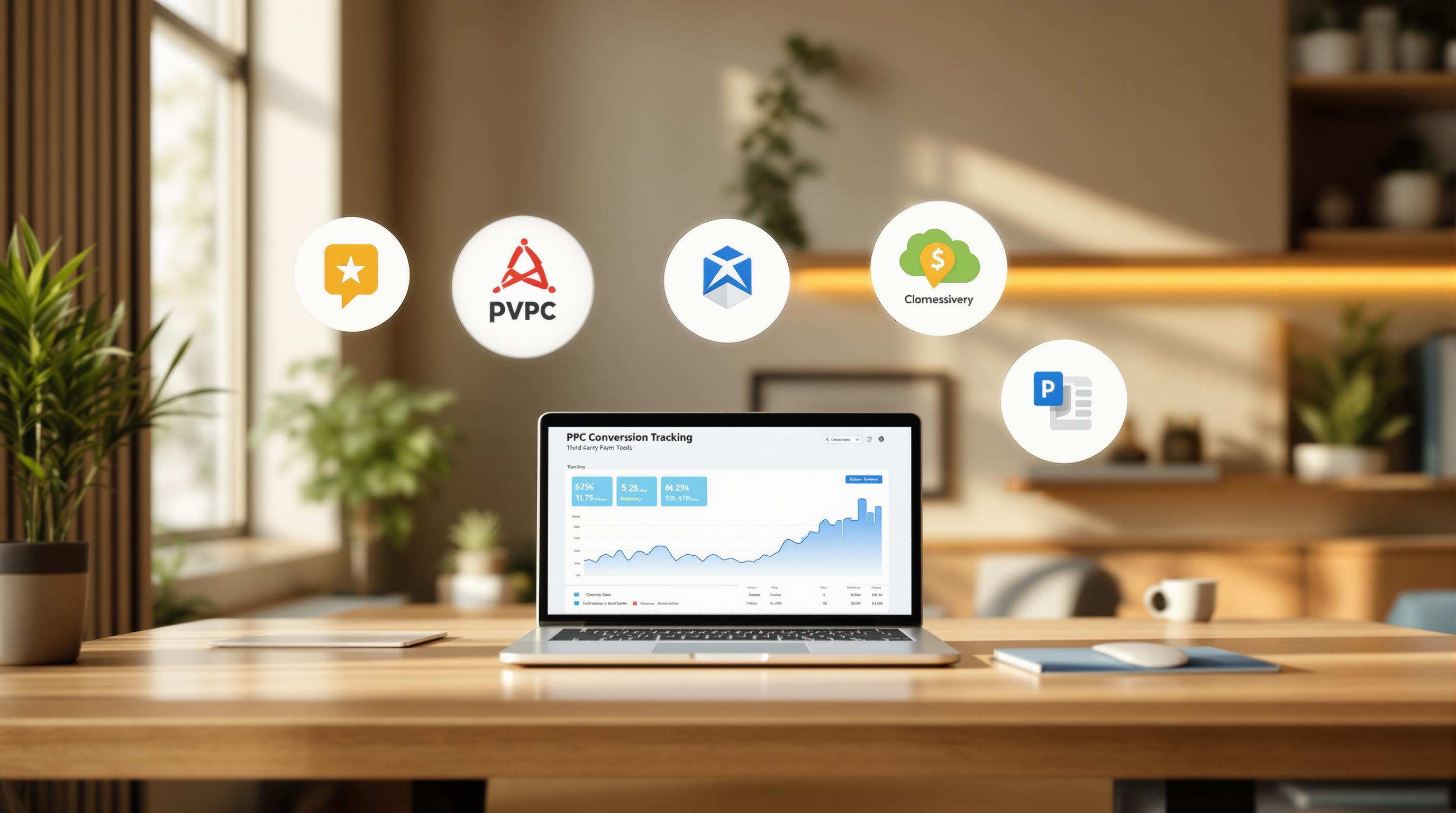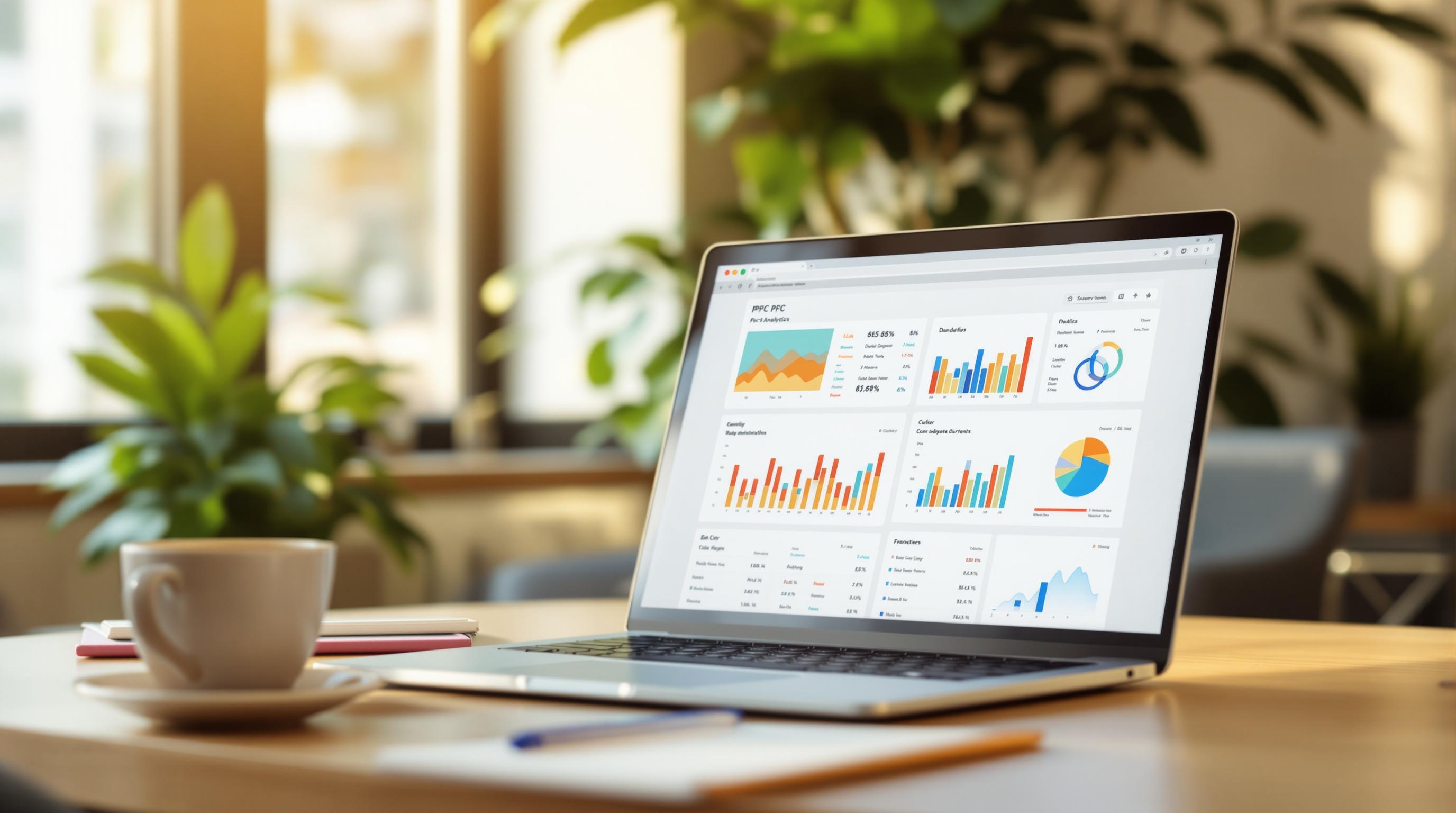Dynamic ad scaling uses AI to improve local PPC campaigns by tailoring ads to specific locations in real time. This method helps businesses save money, increase conversions, and make ads more relevant. Here's what you need to know:
- What It Does: Adjusts ad content, bidding, and targeting based on local data like user behavior, weather, and events.
- Why It Matters: Boosts click-through rates (up to 2.5x), lowers cost per lead (30-40%), and improves ROI by ensuring ads fit local audience needs.
- How It Works:
- Automates ad content with tools like dynamic text replacement.
- Targets locations through ZIP codes, radius settings, and bid adjustments.
- Tracks performance metrics (CTR, ROAS) to refine campaigns.
- Key Tools: Platforms like Optmyzr and Fluency DAOS simplify scaling, cutting ad creation time by up to 60%.
Dynamic ad scaling is ideal for businesses looking to combine localized relevance with efficient ad management, ensuring higher returns on ad spend.
How to Use Dynamic Location Insertion to Improve Your Google Ads
Main Elements of Dynamic Ad Scaling
Dynamic ad scaling combines advanced tools to effectively reach and engage local audiences.
Ad Content Automation
Ad content automation leverages AI to create and fine-tune local ads in real time.
Here’s a breakdown of its key components:
| Component | Function | Impact |
|---|---|---|
| Dynamic Text Replacement | Automatically incorporates location-specific terms | Makes ads more relevant to users |
| Ad Customizers | Adjusts content based on device, location, or time | Boosts click-through rates |
| Creative Optimization | Automatically tests multiple ad variations | Simplifies and speeds up creative processes |
Dynamic creative optimization (DCO) takes this further by using data like user behavior, local weather, nearby events, active promotions, and even geographic pricing to tailor ad strategies.
"Dynamic ads let you scale effortlessly by dynamically pulling content for every product or service you offer - no extra work required." – Pixal Marketing
By pairing automated content with precise targeting, businesses can deliver highly relevant ads that resonate with local audiences.
Location Targeting Setup
Effective location targeting depends on accurate geographic settings and smart bid strategies.
Key elements include:
-
Radius Targeting Configuration
For instance, a kitchen remodeling company might focus on affluent zip codes within a specific radius of its service area. -
Location Bid Adjustments
Bids are adjusted based on metrics like click-through rates (CTR), conversions, return on investment (ROI), and local competition levels.
Location targeting becomes even more powerful when paired with location-based ad extensions. These extensions provide additional details - like a business address or phone number - directly in the ad, improving both visibility and user experience.
Setting Up Dynamic Ad Scaling
Dynamic ad scaling requires careful planning to boost the performance of local campaigns. Let’s break down the key components that make this strategy work effectively.
Local Keyword Integration
Local keywords are the backbone of dynamic ad scaling. Start by diving into keyword research tools like Google’s Keyword Planner to pinpoint high-value search terms specific to your area.
Here’s a simple way to structure your local keyword strategy:
| Keyword Type | Example | Purpose |
|---|---|---|
| City-Based | "plumber in Chicago" | Targets major metropolitan areas |
| Neighborhood | "Brooklyn Heights dentist" | Focuses on smaller, distinct communities |
| Landmark-Based | "hotels near Times Square" | Captures location-specific intent |
| Service Area | "HVAC repair 60601" | Targets specific zip code regions |
To take it a step further, use dynamic text replacement (DTR) in your ad copy. This feature automatically tailors your messaging based on the user’s location, keeping your ads relevant and engaging no matter where they’re seen. Once your keywords are set, the next step is fine-tuning your budget.
Budget Distribution
A smart budget allocation strategy can make or break your ad campaign. For instance, a sporting goods retailer discovered that downtown locations had a 12% conversion rate, compared to just 5% in suburban areas. They adjusted their bids accordingly - raising downtown bids by 20% and lowering suburban bids by 10%.
Here are some key factors to consider:
- Regional Performance Analysis: Use tools like Google Ads and Analytics to evaluate store-level metrics. This helps you identify which locations are delivering the best results and allocate your budget strategically.
- Seasonal Adjustments: Adapt your budget to account for local events, weather changes, or seasonal trends that might affect customer behavior in specific regions.
- Competition Levels: Increase your budget in highly competitive areas to maintain visibility while optimizing for efficiency in less competitive markets.
Tracking and Adjusting
Once your keywords and budget are in place, ongoing tracking is essential to keep your campaign on track. For example, HomElectrical saw a 99% boost in revenue and a 32% increase in clicks by using robust tracking and adjustment systems.
Focus on these metrics:
- Click-through rates (CTR) by location
- Cost per conversion in each region
- Return on ad spend (ROAS) for different geographic segments
- Quality scores for location-specific ad groups
Regularly analyzing these data points allows you to make timely adjustments. Take the example of a grocery chain in Houston: they unified their ad campaigns for five locations within a 10-mile radius, reducing internal competition and improving overall efficiency. With careful tracking and adjustments, you can ensure your campaigns are always performing at their best.
sbb-itb-89b8f36
Local Targeting Techniques
Dynamic ad scaling, when combined with real-time local data, allows businesses to create highly specific and relevant PPC campaigns. This approach fine-tunes ad relevance, making each ad resonate more effectively with its audience.
Weather-Based Ad Updates
Weather has a profound influence on consumer behavior, shaping buying decisions and impacting roughly $3 trillion in the US private sector annually. Walmart's use of weather-based targeting serves as a standout example:
- 80.7% increase in click-through rates (CTR)
- CTR rose from 0.57% to 1.03%
- Swimwear-specific ads achieved a remarkable 1.85% CTR
Here’s how businesses can leverage weather-based ad updates to their advantage:
| Weather Condition | Ad Strategy | Results |
|---|---|---|
| Cold Weather (<60°F) | Promote warm products and services | A leading QSR saw performance exceed benchmarks by 124% with hot soup promotions |
| Hot Weather | Highlight summer items and cooling solutions | Bravissimo boosted swimwear sales revenue by 600% in just three months |
| Rainy Days | Showcase weather-appropriate products | Pure360 recorded a 500% increase in email open rates |
| Sunny Days | Focus on outdoor activities and related products | Stella Cidre experienced a 65.6% YOY sales growth |
By tailoring ads to match weather conditions, businesses can connect with their audience on a more personal level. But that’s not the only way to refine your targeting - local events offer another layer of precision.
Local Event Targeting
While weather-based updates adapt to external conditions, local event targeting zeroes in on community-specific opportunities, making campaigns even more relevant.
To make the most of local event targeting:
- Identify Key Local Events: Find events that align with your business offerings, like concerts, sports games, or festivals.
- Adjust Bidding Strategies: Time your bids to coincide with peak local interest during these events.
- Customize Ad Creative: Tailor your ad copy to the event, such as offering game day specials for restaurants near sports venues.
A major QSR demonstrated how blending event and weather targeting can amplify results. They adjusted their menu promotions based on weather and meal times:
- Below 60°F: Advertised hot soups.
- Above 60°F: Focused on fresh salads and sandwiches.
This dual-targeting strategy led to a 124% improvement over their benchmark metrics.
Tools for Dynamic Ad Scaling
Dynamic ad scaling thrives on effective automation and precise local targeting. Modern PPC tools simplify campaign management while delivering measurable outcomes. One standout resource for finding such tools is the Top PPC Marketing Directory, a curated guide to tools that handle campaign management, bid optimization, and performance tracking.
To illustrate the impact of these tools, here are some real-world examples:
| Business Case | Tool Used | Results |
|---|---|---|
| BH Management Services | Digital Advertising Operating System | • Saved over $800,000 in management costs • Reduced Cost Per Lead by 40% • Lowered Cost Per Conversion by 35% |
| Click Here Digital | Fluency DAOS | • Cut new account launch times by 91% • Reduced optimization time by 40% • Slashed ad creation time from 75 to 30 minutes |
| Bruce Automotive Group | Optmyzr | • Achieved a 100% increase in click-through rates • Reduced ad spend by 40% |
When choosing tools for dynamic ad scaling, focus on features that enhance automation, local targeting, and analytics. Here's how these capabilities directly impact local campaigns:
| Feature Category | Key Capabilities | Impact on Local Campaigns |
|---|---|---|
| Automation | • Automated bid adjustments, keyword research, and performance tracking | Cuts manual work by 43% per analyst |
| Local Targeting | • Geographic targeting • Weather-based updates • Event-specific bidding |
Allows for precise audience targeting |
| Analytics | • Real-time performance analysis • Multi-platform tracking • Budget alerts |
Drives data-informed campaign optimization |
"With smartly, we can now do that in minutes" - G2 Review
For businesses at different stages, here’s a quick pricing breakdown of some popular tools:
- Entry-Level Options: AdEspresso ($49/month), SpyFu ($39/month)
- Mid-Range Tools: Adalysis, CHEQ Essentials (both $149/month)
- Advanced Solutions: Optmyzr ($249/month), Semrush ($139.95/month)
Summary
Here’s a quick recap of the results achieved and a streamlined approach to implementing dynamic ad scaling effectively.
Results of Dynamic Ad Scaling
Dynamic ad scaling has shown a powerful ability to boost engagement across critical metrics:
| Metric | Impact of Local Dynamic Scaling |
|---|---|
| Click-Through Rate | 2.5x higher compared to non-local search |
| Cost per Lead | 30-40% lower than standard campaigns |
| Conversion Rate | Up to 80% higher with local targeting |
| Return on Ad Spend | Average 200% for successful campaigns |
These numbers highlight the value of precise local targeting and dynamic adjustments. For instance, one company customized PPC ad copy and landing pages for various U.S. states, which led to their CTR jumping from 1% to 8% and conversion rates climbing from under 1% to 7% in just six months.
These insights set the foundation for the following step-by-step implementation guide.
Implementation Guide
| Phase | Actions | Outcome |
|---|---|---|
| Initial Setup | • Group campaigns by geographic focus • Enable dynamic keyword insertion • Create location-specific landing pages |
Better targeting precision |
| Optimization | • Use ad customizers to include local details • Implement dynamic text replacement • Track performance metrics closely |
Stronger message alignment |
| Scaling | • Expand campaigns to new regions • Adjust bids based on local performance • Fine-tune targeting settings |
Consistent growth |
Real-world examples back up this approach. Starbucks leveraged geo-fencing in their app to deliver location-based promotions, driving more foot traffic and boosting sales. Similarly, UNIQLO's location-based campaign in Japan brought over 200,000 store visits in just six days.
With 85% of online consumers engaging with brands at a local level, adapting to local markets while maintaining a consistent brand message is crucial. Regularly monitoring and tweaking campaigns ensures they deliver maximum ROI and performance.
FAQs
How does dynamic ad scaling boost the effectiveness of local PPC campaigns compared to traditional methods?
Dynamic ad scaling takes local PPC campaigns to the next level by automatically generating ads that match a user's search intent and location in real time. Instead of sticking with static ad copy, this method uses live data to fine-tune ad content, making it more relevant to what potential customers are actively looking for. The result? Higher click-through rates (CTR) and conversion rates, as users are presented with ads that speak directly to their needs.
On top of that, dynamic ad scaling eliminates much of the manual work involved in tasks like keyword research and ad creation. By automating these processes, businesses can focus their time and resources elsewhere while still effectively reaching their local audience. This approach not only saves effort but also boosts campaign performance, making it a smart choice for businesses looking to get the most out of their geographically targeted campaigns.
What should I focus on when setting up location targeting for dynamic ad scaling in local PPC campaigns?
When setting up location targeting for dynamic ad scaling in local PPC campaigns, there are a few critical steps to keep your ads relevant and cost-efficient.
Start by defining your target locations. Whether it’s specific states, cities, or zip codes, focus on areas where your business operates or where your ideal customers are most likely to be. This kind of precision ensures your ads reach the right audience while minimizing wasted ad spend.
Don’t forget to exclude irrelevant areas. Using negative geo-targeting, you can block locations that fall outside your service area or where conversions are unlikely. This helps keep your budget concentrated on regions with higher potential.
Lastly, adapt to local competition and customer behavior. Adjust bids and messaging to align with the preferences and conditions of specific markets. By segmenting campaigns by location, you can craft more tailored and effective ad strategies.
By keeping these factors in mind, you can fine-tune your campaigns and make the most of your advertising budget.
What tools are best for automating dynamic ad scaling in local PPC campaigns, and what features should businesses prioritize?
To make local PPC campaigns more effective and efficient, businesses should consider tools that use AI and machine learning to handle tasks like real-time bid adjustments and budget management. For example, Google's Smart Bidding stands out as a powerful option, using historical data and user behavior insights to help maximize ROI while cutting down on unnecessary ad spend.
When choosing tools, focus on features like automated bid management, dynamic creative optimization (DCO), and smart budget allocation. DCO is particularly impactful - it customizes ad content in real time based on user preferences, which can significantly improve engagement and drive more conversions. By tapping into these advanced features, businesses can elevate the performance of their local campaigns and see stronger results.


